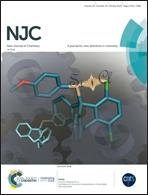Half-lantern cyclometalated Pt(ii) and Pt(iii) complexes with bridging heterocyclic thiolate ligands: synthesis, structural characterization, and electrochemical and photophysical properties†‡
Abstract
The half-lantern Pt(II)–Pt(II) cyclometalated complexes [{Pt(ppy-κ2C,N)(μ-N^S)}2] [Hppy = 2-phenylpyridine; HN^S = 2-mercaptopyridine (Spy, 1a), 5-(trifluoromethyl)-2-mercaptopyridine (SpyCF3, 1b), 2-mercaptopyrimidine (SpyN, 1c), 2-mercaptobenzothiazole (SBt, 1d) and 2-mercaptobenzimidazole (SBi, 1e)] were synthesized by reaction of [Pt(ppy-κ2C,N)Cl(dmso)] (A) with an ethanolic solution of the corresponding sodium thiolate salts, thus providing a new direct approach to obtain this type of complexes in high yield. 1a, 1d and 1e were previously reported by other routes (see the text). These complexes exhibit intense red emission (QY 13.2–37.4%, CH2Cl2) derived from a triplet metal–metal to ligand charge transfer (3MMLCT) excited state both in CH2Cl2 solution and in the solid state (298 and 77 K), consistent with strong Pt⋯Pt interactions. The electrochemical behavior of these complexes was examined to get insight into the influence of the bridging ligand on the metallointeractions. By stirring compounds 1a–c in CHCl3, two electron oxidized diplatinum(III) derivatives [{Pt(ppy-κ2C,N)(μ-N^S)Cl}2] (2a–c) were successfully obtained (2a previously reported by Kato et al.). The X-ray structure of 2c·CHCl3 confirmed the retention of the half-lantern structure for the Pt(III)–Pt(III) dichloro complex and a shortening of the Pt–Pt distance in relation to 1.



 Please wait while we load your content...
Please wait while we load your content...